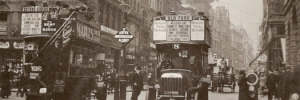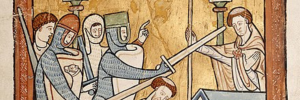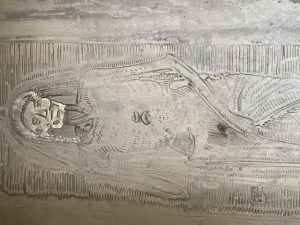London, with its rich tapestry of history, boasts an array of architectural wonders that serve as milestones in the city’s long and complex story. Among them, the Old St Paul’s Cathedral holds a special place. Far more than just a religious edifice, this iconic structure once towered over the medieval City of London, embodying the city’s spiritual, cultural, and architectural ambitions.
Founded as a diocesan cathedral in AD 604, the edifice underwent several renovations and expansions over the centuries. By the Medieval period, it had morphed into one of Europe’s largest cathedrals, with a spire reaching an impressive 489 feet. The cathedral served not just as a house of worship but also as a vibrant community hub and a symbol of London’s emerging status as a major European city.
Few structures in the City of London have exerted as much influence over religious and civic life as the Old St Paul’s Cathedral. While the cathedral itself remains a subject of much scholarly discourse, one aspect often overlooked is the Chapter House. As we explore the layered history of this
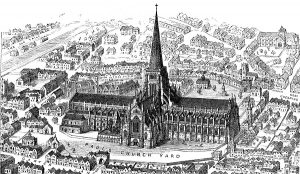
architectural gem, we shall discover how the Chapter House was not just an ancillary structure but a significant player in the religious, legal, and social fabric of the City of London.
The Original Splendour: The Making of a Masterpiece
Consecrated in 1240 but with a history dating back to the 7th century, the medieval St Paul’s Cathedral was a marvel of its time. Inspired by Gothic architecture, its construction was an audacious endeavour. The cathedral was distinguished by its towering spire, reaching a remarkable 149 metres, a feat not surpassed until the completion of the Lincoln Cathedral in the 14th century. It was a symbol of London’s aspiration and grandiosity, serving as a prominent landmark visible from miles away.
Architectural Grandeur: Features that Stood Out
One of the cathedral’s most arresting features was its nave, which was one of the longest in England. Adorned with intricate woodwork and ornate stone sculptures, the nave was an avenue of spiritual awakening for worshippers and visitors alike. Equally impressive was its transept, featuring rose windows that cast a kaleidoscope of colours onto the interior, invoking a sense of divine presence. The cloisters and Chapter House, the venue for clergy meetings and canonical deliberations, were testaments to the religious life centred around the cathedral.
The Chapter House
Chapter houses were generally constructed as an adjunct to the main cathedral structure, often adjoining the cloister. The Chapter House of Old St Paul’s was no exception. While exact details are limited due to the absence of surviving blueprints from before the Great Fire, written accounts and sketches depict a structure of exceptional beauty. It was a place where Gothic architectural elements met the simplicity and grandeur characteristic of English ecclesiastical buildings. Arched windows likely allowed natural light to illuminate the intricate masonry and frescoes that adorned its interior, creating an atmosphere of divine sanctity.
The Chapter House was an essential part of the Old St Paul’s Cathedral, which was consecrated in the early 14th century. Situated usually on the eastern part of a cathedral, a Chapter House is where the clergy would convene for daily meetings and was also often used for ecclesiastical court. As was customary for Gothic architecture, its design likely included ornate detailing, with complex ribbed vaults and intricate stone carving.
Uses and Functions: Beyond a Meeting Room for the Clergy
While the primary function of a chapter house was to serve as a meeting place for the cathedral chapter—the clergy associated with the cathedral—the Chapter House at Old St Paul’s extended its utility beyond this role. In addition to being a space for theological discussions, decision-making, and ecclesiastical governance, it often hosted legal proceedings and, at times, civic functions. The versatility of the Chapter House made it a microcosm of the cathedral’s wider role in London’s social, religious, and even political life.
Artistic and Cultural Resonance: A Treasury of Spiritual Art
Although no physical artefacts survive, accounts tell us that the Chapter House was likely a treasure trove of religious art. The presence of frescoes, intricate masonry, and possibly even stained glass windows would have made it a serene yet grandiose space. It was common in these spiritual precincts to use art as a medium for storytelling—depicting scenes from the Bible or the lives of saints, for instance, thus engaging the laity and clergy alike in a visual form of worship.
The Catalyst of Change: The Great Fire of 1666
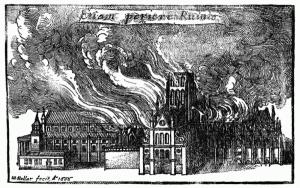
Fate, however, was not kind to this marvel. In 1666, the Great Fire of London ravaged the city, reducing the Old St Paul’s Cathedral to ruins. The fire consumed not just the wood and stone but also an integral part of London’s identity. What followed was a period of reflection and reconstruction, spearheaded by the architect Sir Christopher Wren, which eventually gave rise to the new St Paul’s Cathedral. Although distinct in design, the new structure paid homage to its predecessor while embodying the architectural and social shifts of a London reborn.
The Role in Ecclesiastical and Civic Life
Beyond being merely a meeting place for clergy, the Old St Paul’s Chapter House played a significant role in the broader ecclesiastical and civic life of London. It served as a venue for various church councils and synods, contributing to shaping religious doctrines and canon law. Moreover, the Chapter House occasionally functioned as a court, underlining its dual religious and legal significance.
The Impact of the Reformation
The Reformation brought about considerable changes to religious life in England, and the Old St Paul’s Chapter House was not immune to these shifts. As the nation moved from Catholicism to Protestantism, the function and status of such ecclesiastical buildings came under scrutiny. In many instances, Chapter Houses were repurposed or fell into disuse, and unfortunately, detailed records of the Chapter House’s condition during this period are scant.
Destruction and Legacy
The demise of the Old St Paul’s Chapter House came with the Great Fire of London in 1666. Alongside much of the cathedral, this iconic structure succumbed to the flames, leaving only ruins in its wake. In the rebuilding effort led by Sir Christopher Wren, the new St Paul’s Cathedral emerged as an architectural marvel of its time, but the original Chapter House was lost forever.
However, its legacy lives on. Surviving documents and drawings offer clues to its original design, and it remains a subject of interest for historians and architects alike. The Chapter House serves as a silent yet eloquent witness to the various periods of London’s history, from the medieval times to the Reformation and beyond.
As we navigate the sprawling historical landscape of London, buildings like the Old St Paul’s Chapter House remind us of the multi-layered narrative that has shaped the city. Though it no longer stands, the Chapter House endures as a crucial element in the rich tapestry of London’s history, offering invaluable insights into the religious, social, and architectural developments that have marked the city through the ages. It may be gone, but it is far from forgotten, continuing to fascinate all who delve into the story of this ever-evolving metropolis.


